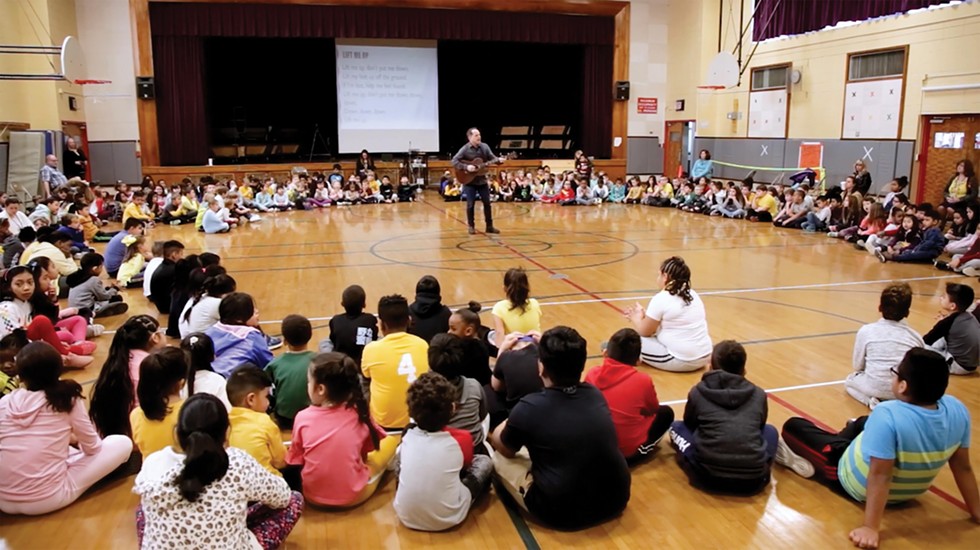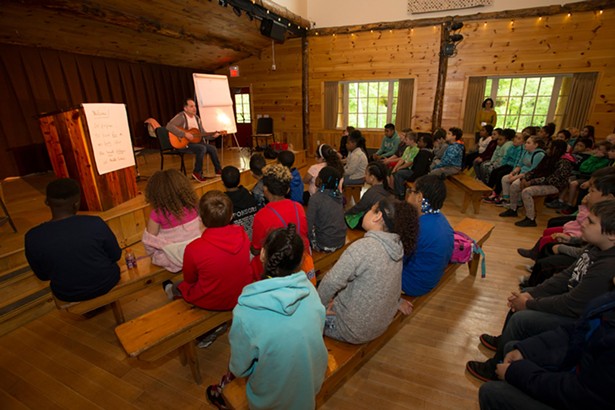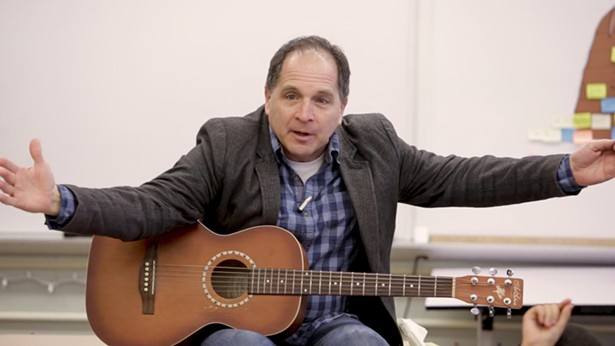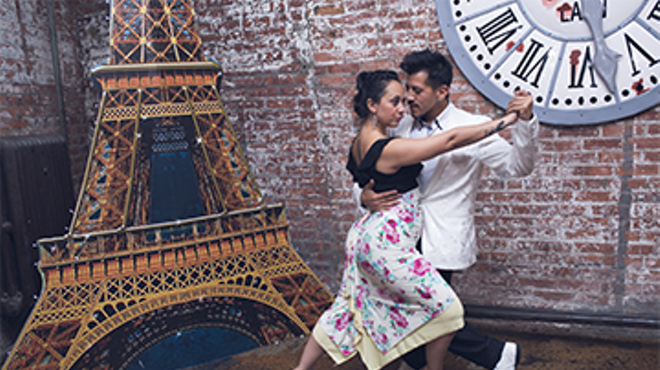In December 1989, David Levine was teaching a lesson to fifth graders in Portland, Maine. "It was one of those moments you never forget, like a permanent snapshot," Levine says. "I started singing a song—that I'd been singing all over the country for years—and it hit me," Levine says. "I had a vision of the word empathy inside of a picture frame, and I realized the song was about empathy, but this was in 1989 before empathy was a word people used." One of the students looked up empathy in a dictionary. "The kid said it's like going to a museum and looking at someone's painting and feeling what they felt when they painted it," Levine says, recalling the pivotal moment when he realized that teaching empathy would be his life's work.
Levine earned a master's degree in Creative Arts in Learning from Lesley University in Cambridge, Massachusetts, and has over 30 years of experience as a teacher, facilitator, and systems change specialist. He has consulted school districts up and down the Hudson Valley and New York City and founded the Teaching Empathy Institute (TEI), based in Stone Ridge, in 2016.
Levine uses songs to enter into dialogue with the kids, and he has several he often sings for the kids, but one of the hallmarks of his program is "Howard Gray," the song that inspired it all, written by Lee Domann from Nashville. "Howard Gray" is based on the true story of a kid who was bullied, and like all great storytelling, the universal becomes personal when attached to a narrative. When Levine sings "Howard Gray," the kids sit riveted, thinking about times they've been bullied and times they could've been kinder to their peers. "TEI focuses on a very complex issue—the social and emotional well-being of children, young adults, and adults in our schools—which requires nurturing relationships that are empathic, trusting, and meaningful," Levine says.
Between 2016 and 2023, TEI's School of Belonging Program has been focused in the Kingston, Rondout, Ellenville, Rhinebeck, and Wappingers Falls school districts, but now he wants to scale the work digitally to allow schools and communities across the United States, and the world, to access it. TEI developed an asynchronous curriculum from the work it created in Kingston and piloted this program with schools in Ghana, South Africa, Dubai, and England. The documentary film, Finding Howard, is about Dolmann and some of his childhood classmates reminiscing about Howard after his death and their regret over how they'd treated him. The film was recognized at Helsinki's Education Film Festival as Best Film for Youth Welfare in 2021.
Teaching Empathy
Levine doesn't wear costumes to the classrooms; he's just a regular guy in jeans and a sweater. But he doesn't go to schools empty-handed, and his magic lies within his instruments. Levine's tools are his guitar and a Vibra-Tone—which plays a deep, resonant sound similar to singing bowls—that Levine uses to get the kids to focus. It works. I witnessed it firsthand several times; elementary-age kids are easily distracted.
In a fourth-grade classroom at Chambers Elementary in Kingston, Levine asked the kids to be still and quiet—to really listen—to what's going on and to observe with eyes and ears not what is right or wrong, but what is real. "Why are some people rejected?" Levine asks the kids. Students in the class raised eager hands and said it's because of how they look, how they dress, their skin color, or the way they act.
"And how does it feel to be rejected?" Levine asked. Again, hands flew up, and the kids said it feels sad, angry, and lonely.
"You can help people by including them," Levine says, "And if you learn how to listen and ask questions, you're choosing to connect." Levine explains that sympathy is feeling sorry for someone, but empathy is when you try to understand how they're feeling. "Think about what would make you feel better if you were the new kid in a class, or the one never picked for sports, or the one struggling with grades," Levine says. "And think about what would make you feel better. It's about more than just being nice."
Fourth graders are preparing for middle school, and many of them expressed that they're already thinking about what they'll wear, worried about forgetting their locker combination and getting lost, or riding the bus with "big kids." The things kids worry about now are the same things kids have worried about for generations, except they're moving through these stressors in an increasingly complicated world. Today's fourth graders were in kindergarten when the pandemic began, and their ability to connect with others and self-regulate is different.
Levine encourages the kids to close their eyes and imagine themselves like trees with deep, grounding roots so they'll be prepared for the wind and other elements, a metaphor for entering middle school. Levine talks to the fourth graders about what stops people from raising their hand in class—because they're worried they might be wrong and then people might laugh at them—and while talking about vulnerability and a willingness to take social risks might seem above their grade level, Levine speaks straight to their hearts and the kids get it. Maybe they don't completely understand these more profound concepts, but the seeds are planted.
"We all want choice," Levine says, "When you give kids a choice—and you also name it for them—you're also honoring them and giving them a voice, so you're meeting their emotional needs. And when kids' needs are met, their motivation is sky-high."
If the School of Belonging has yet to come to a certain school district, but parents want to incorporate these principles into their home life, TEI also has a digital program called Belonging at Home, which was released during the pandemic.
Empathy Training—Not Just for Kids
"Empathy is misunderstood in a whole bunch of ways, but one of the ways I think it's most misunderstood is in the belief that some people are naturally empathetic and other people are not," says Karen Faith, a Duchess County-based ethnographer-turned-empathy trainer and the creator of the Others curriculum. "I disagree with the idea that empathy is inherently in someone or not in someone," Faith says, "But if I had to speak about the nature of empathy, I'd say that I find it to be in a certain way unnatural, but that depends on what kind of empathy you are talking about because there are three different kinds of empathy."
Affective empathy is the emotional kind when we care about other people and are concerned for their well-being and happiness. "It's feeling sad when other people are sad," Faith explains. "This kind of empathy is very emotional and usually centered around people who are suffering."
Somatic empathy is when your physical experience mirrors that of another person. "It's very spooky, and it's very rare," Faith says, "But it does happen when you physically feel another person's pain."
Cognitive empathy is the kind that Faith teaches and focuses on. "Cognitive empathy is the mental skill and habit of perspective-taking; it's a stepping aside and asking enough questions to learn about another person's experience," she says, "And that may not involve any emotions at all. It may not involve any sense of agreement, resonance, sympathy, or compassion. It's really just a way of understanding others."
Faith explains that cognitive empathy isn't inherent. "It's not natural to know how to see things through another's eyes or to think about things with a mind that isn't ours," Faith says. "That isn't anyone's default; it must be learned."
Empathy Can Be Learned
"Everyone can learn empathy, and it's a teachable skill that comes down to curiosity and nonjudgment," Faith says. When we add curiosity to a spirit of nonjudgment, we're able to learn more about others—and ourselves—because we're not shutting things out. "When we practice, it enables us to take perspectives that we may not have expected," Faith says, "And the side effect is that we end up caring and feeling more." We've learned that neurodiverse people have more difficulty accessing others and reading social cues like facial expressions and body language. "Cognitive empathy training is a great way to get around some of those obstacles, and it helps give every kind of mind an entry point into the practice."
Like the kids who have the privilege of attending TEI workshops, adults also crave connection and belonging. "When the public talks about empathy, they're talking about compassion, almost all the time," Faith says, "And compassion is cool, but if I were to try to teach compassion, I'd start with cognitive empathy because we can't care about each other until we understand each other."
A deeper interest in understanding each other is the key to bringing more empathy into your life. Between the Israel-Hamas war and our red-and-blue-divided country, many have fallen into a refusal to see things from any other point of view. "It's not just a righteousness about my point of view, but a fear of finding out that there are holes in my point of view," Faith says. "I'll never get tired of saying that empathy doesn't scale. Empathy is a one-on-one practice. And the minute you make a rule that applies to many people, you've stopped practicing empathy."
Faith stresses that empathy doesn't apply to people who look like you, who sound like you, or who come from where you come from. We often think about empathy as relating to others, and we think it's empathy when we say, "I've been going through the same thing," but Faith says it's actually about seeking out the difference. "The next time you catch yourself saying, 'Yeah, me too, I totally get that,' stop yourself and instead ask more questions until you find the place where their story differs from yours."
For example, when you meet someone who also experienced the loss of a loved one, instead of finding the commonality between your experiences, ask enough questions until you find the difference. "Tell me more, tell me more," Faith says, "Ask more questions until you find the difference because otherwise, you aren't learning about that other person's perspective. You're just assuming that you have things in common."
First Understand Yourself
Self-witnessing and self-responsibility are key because another misconception is that empathy is only focused on other people. "It's about understanding others, caring for others, and listening to others, but none of that works if we haven't done our personal homework," Faith says. We have to take responsibility for the fact that we may not have control over anything else in the world outside of ourselves, so we need to look inside at where we're refusing to see things, what things we're scared to know, what we're judging, rejecting, or just refusing to look at. "Whatever we refuse to see or accept about ourselves will be a blind spot or a focal point in how we see others," Faith says.
"There are a lot of people right now who feel lonely, disconnected, and in need of relationships and belonging," Levine says, referencing the work of Martin Brokenleg, a Native American psychologist who is an expert in trauma and resilience. "Brokenleg says when we're under stress, we go where we belong. Wouldn't it be awesome if the classroom was the place where we belong?"
















